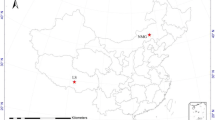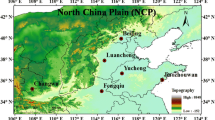Abstract
Photosynthetically active radiation (PAR) and other solar components were observed for a period of 3 years at Wuhan, China to determine for the first time the temporal variability of PAR fraction [PAR/G (G here stands for global solar radiation)] and its dependence on different sky conditions in Central China. PAR, G and PAR/G showed similar seasonal features that peaked in summer and reached their lowest values in winter. The seasonal PAR/G ranged from 1.70 E MJ−1 (winter) to 2.01 E MJ−1 (summer) with an annual mean value of 1.89 E MJ−1. Hourly values of PAR/G increased from 1.78 to 2.11 E MJ−1 on average as sky conditions changed from clear to cloudy. Monthly mean hourly PAR/G revealed a diurnal variation, with highest values observed around sunrise and sunset, slightly higher PAR fractions were also found around noon for most months. The effect of daylength on PAR/G was also studied and no significant impact was found. Three models were developed to estimate PAR from G. These models consisted of atmospheric parameters that were found to cause substantial changes of PAR/G, such as sky clearness, brightness, path length and the sky clearness index. The estimations obtained from different models were very close to the measured values with maximum relative errors below 8 % (hourly values) in Wuhan. The models were not only tested at seven radiation stations in Central China, but also verified in six stations with different climates in China. The models were found to estimate PAR accurately from commonly available G data in Central China; however, the results also implied that the models need to be modified to account for local climatic conditions when applied to the whole country.









Similar content being viewed by others
References
Aguiar LJG, Fischer GR, Ladle RJ, Malhado AC, Aguiar RG (2012) Modeling the photosynthetically active radiation in South West Amazonia under all sky conditions. Theor Appl Climatol 108:631–640
Alados I, Arboledas LA (1999) Validation of an empirical model for photosynthetically active radiation. Int J Climatol 19:1145–1152
Alados I, Moreno IF, Arboledas LA (1996) Photosynthetically active radiation: measurements and modelling. Agric For Meteorol l78:121–131
Bruce W (1996) A new method for calibrating reference and field pyranometers. J Atmos Oceanic Technol 13:638–645
Cai YJ, Tan LC, Cheng H, An ZS, Edwards RL (2010) The variation of summer monsoon precipitation in central China since the last deglaciation. Earth Planet Sci Lett 291:21–31
Clay GD, Worrall F, Rose R (2010) Carbon budgets of an upland blanket bog managed by prescribed fire. J Geophys Res 115: G04037
Duan J, Liu Y (2011) Variation and trends of cloud amount in China over past 20 years. Meteorol Sci Technol 39:280–288
Dye DG (2004) Spectral composition and quanta-to-energy ratio of diffuse photosynthetically active radiation under diverse cloud conditions. J Geophys Res 109:D10203. doi:10.1029/2003JD004251
Escobedo JF, Gomes EN, Oliveira AP, Soares J (2009) Modeling hourly and daily fractions of UV, PAR and NIR to global solar radiation under various sky conditions at Botucatu, Brazil. Appl Energ 86:299–309
Finch DA, Bailey WG, McArthu LJB, Nasitwitwi M (2004) Photosynthetically active radiation regimes in a southern African savanna environment. Agric For Meteorol 122:229–238
Frouin R, Pinker RT (1995) Estimating photosynthetically active radiation (PAR) at the earth’s surface from satellite observations. Remote Sens Environ 51:98–107
Gao ZQ, Xie XP, Gao W, Chang NB (2011) Spatial analysis of terrain-impacted Photosynthetic Active Radiation (PAR) using MODIS data. GIScience Remote Sens 48:501–521
Geiger M, Diabate LM, Wald L (2002) A web service for controlling the quality of measurements of global radiation. Sol Energ 73:475–480
Gong W, Wang LC, Lin AW, Zhang M (2012) Evaluating the monthly and interannual variation of net primary production in response to climate in Wuhan during 2001 to 2010. Geosci J 16(3):347–355
Gonzalez JA, Calbo J (2002) Modeled and measured ratio of PAR to global radiation under cloudless skies. Agric For Meteorol 110:319–325
Han ZW, Li JW, Xia XG, Zhang RJ (2012) Investigation of direct radiative effects of aerosols in dust storm season over East Asia with an online coupled regional climate-chemistry-aerosol model. Atmos Environ 54:688–699
Howell TA, Meek DW, Hatfield JL (1983) Relationship of photosynthetically active radiation to shortwave radiation in the San Joaquin Valley. Agric For Meteorol 28:157–175
Hoyle CR, Myher G, Isaksen I (2009) Present-day contribution of anthropogenic emissions from China to the global burden and radiative forcing of aerosol and ozone. Tellus B 61:618–624
Hu B, Wang YS, Liu GR (2007) Measurements and estimations of photosynthetically active radiation in Beijing. Atmo Res 85:361–371
Hu B, Wang YS, Liu GR (2010) Variation characteristics of ultraviolet radiation derived from measurement and reconstruction in Beijing, China. Tellus B 62:100–108
Iqbal M (1983) An introduction to solar radiation. Academic, Toronto
Jacovides CP, Tymvios FS, Asimakopoulos DN, Pashiardes S (2003) Global photosynthetically active radiation and its relationship with global solar radiation in the eastern Mediterranean basin. Theor Appl Climatol 74:227–233
Janjai S, Wattan R (2011) Development of a model for the estimation of photosynthetically active radiation from geostationary satellite data in a tropical environment. Remote Sens Environ 115:1680–1693
Joshi KB, Costello JH, Priya S (2011) Estimation of Solar Energy Harvested for Autonomous Jellyfish Vehicles (AJVs). IEEE J Oceanic Eng 36:539–551
Kasten F, Young A (1989) Revised optical air mass tables and approximation formula. Appl Optic 28:4735–4738
Li R, Zhao L, Ding YJ, Wang S, Ji GL (2010) Monthly ratios of PAR to global solar radiation measured at northern Tibetan Plateau, China. Sol Energ 84:964–973
Liu RG, Liang SL, He HL, Liu JY, Zheng T (2008) Mapping incident photosynthetically active radiation from MODIS data over China. Remote Sens Environ 112:998–1009
Liu RX, Chen HB, Zheng ZJ, Liu NQ, Shi CX, Liu YJ (2009) Analysis and validation of total cloud amount data in China. J Appl Meteorol Sci 20:571–578
Lorente J, Redan A, Cabo X (1994) Influence of urban aerosol on spectral solar irradiance. J Appl Meteorol 33:406–415
Lorenzo AS, Calbo J, Brunetti M, Deser C (2009) Dimming/brightening over the Iberian Peninsula: Trends in sunshine duration and cloud cover and their relations with atmospheric circulation. J Geophys Res 114:D00D09
Loutzenhiser PG, Manz H, Felsmann C, Strachan PA, Frank T (2007) Empirical validation of models to compute solar irradiance on inclined surfaces for building energy simulation. Sol Energ 81:254–267
Mayer H, Holst T, Schindler D (2002) Microclimate within beech stands - Part 1: photosynthetically active radiation. Forstw Cbl 121:301–321
McCree K (1972) Test of current definitions of photosynthetically active radiation against leaf photosynthesis data. Agric Meteorol 10:443–453
Mottus M, Ross J, Sulev M (2001) Experimental study of ratio of PAR to direct integral solar radiation under cloudless conditions. Agric For Meteorol 109:161–170
Ohde T, Seigel H (2012) Impacts of Saharan dust and clouds on photosynthetically available radiation in the area off Northwest Africa. Tellus B 64:1–17
Padovan A, Col DD (2010) Measurement and modeling of solar irradiance components on horizontal and tilted planes. Sol Energ 84:2068–2084
Papaioannou G, Nikolidakis G, Asimakopoulos D, Retalis D (1996) Photosynthetically active radiation in Athens. Agric For Meteorol 81:287–298
Perez R, Ineichen P, Seals R, Michalsky J (1990) Modeling daylight availability and irradiance components from direct and global irradiance. Sol Energy 44:271–289
Ross J, Sulev M (2000) Sources of errors in measurements of PAR. Agric For Meteorol 100:103–125
Tsubo M, Walker S (2005) Relationships between photosynthetically active radiation and clearness index at Bloemfontein, South Africa. Theor Appl Climatol 80:17–25
Udo SO, Aro TO (1999) Global PAR related to global solar radiation for central Nigeria. Agric For Meteorol 97:21–31
Van PE, Sanchez GA (2005) Mapping PAR using MODIS atmosphere products. Remote Sens Environ 94:554–563
Wang Q, Tenhunenb J, Schmidtb M, Kolcunb O (2006) Estimation of total, direct and diffuse PAR under clear skies in complex alpine terrain of the National Park Berchtesgaden, Germany. Ecol Modell 196:149–162
Wang Q, Kakubari Y, Kubota M, Tenhunen J (2007) Variation of PAR to global solar radiation ratio along altitude gradient in Naeba Mountain. Theor Appl Climatol 87:239–253
Wang LC, Gong W, Ma YY, Zhang M (2013) Modeling regional vegetation NPP variations and their relationships with climatic parameters in Wuhan, China. Earth Interact 17:1–20. doi:10.1175/2012EI000478.1
Wortman E, Tomaszewski T, Waldner P, Schleppi P (2012) Atmospheric nitrogen deposition and canopy retention influences on photosynthetic performance at two high nitrogen deposition Swiss forests. Tellus B 64:17216
Xia X, Li Z, Wang P, Chen H, Cribb M (2007) Estimation of aerosol effects on surface irradiance based on measurements and radiative transfer model simulations in northern China. J Geophys Res 112:D22S10
Xia X, Li Z, Wang P, Cribb M, Chen H, Zhao Y (2008) Analysis of photosynthetic photon flux density and its parameterization in Northern China. Agric For Meteorol 148:1101–1108
Yan P, Zhang RJ, Huan N, Zhou XJ (2012) Characteristics of aerosols and mass closure study at two WMO GAW regional background stations in eastern China. Atmos Environ 60:121–131
Yang JM, Qiu JH (2002) A method for estimating precipitable water and effective water vapor content from ground humidity parameters. Chin J Atmos Sci 26:9–26
Yu Y, Chen HB, Xia XA (2010) Significant variations of surface Albedo during a snowy period at Xianghe observatory, China. Adv Atmos Sci 27:80–86
Zhang X, Zhang Y, Zhao Y (2000) Measuring and modeling photosynthetically active radiation in Tibetan Plateau during April–October. Agric For Meteorol 102:207–212
Zheng J, Tan M, Shibata (2004) Characteristics of lead isotope ratios and elemental concentrations in PM10 fraction of airborne particulate matter in Shanghai after the phase-out of leaded gasoline. Atmos Environ 38:1191–1200
Zhou YH, Xiang YQ, Shang FZ (1984) A climatological study on the photosynthetically active radiation. Acta Meteol Sinica 42:387–397
Zhou Y, Xiang Y, Luan L (1996) Climatological estimation of photosynthetically active quantum flux. Acta Meteol Sinica 54(4):447–454
Zhu ZC, Kong LL, Xia K (2009) Analysis of PM10 source in Wuhan and its countermeasures. Environ Sci Technol 32:64–67
Acknowledgments
This work was supported financially by the National Basic Research Program (2011CB707106) and and NSFC (Program: 10978003 and No.41127901). We thank CERN for providing the observation data, we also would like to thank the reviewers for constructive comments.
Author information
Authors and Affiliations
Corresponding authors
Rights and permissions
About this article
Cite this article
Wang, L., Gong, W., Ma, Y. et al. Photosynthetically active radiation and its relationship with global solar radiation in Central China. Int J Biometeorol 58, 1265–1277 (2014). https://doi.org/10.1007/s00484-013-0690-7
Received:
Revised:
Accepted:
Published:
Issue Date:
DOI: https://doi.org/10.1007/s00484-013-0690-7




